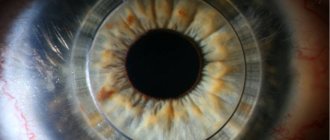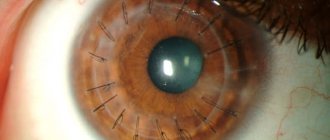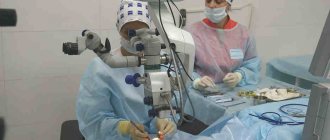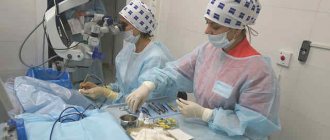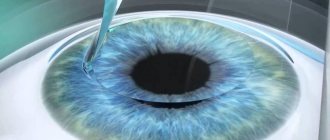The essence of the operation
The refractive method of keratotomy (radial or laser) is an operation aimed at vision correction. This technique consists of forming non-through incisions on the anterior cornea of the eye. After such an incision at the micron level, the scarring process begins. As a result, after tissue restoration, the cornea takes on a natural shape, due to which the rays are focused directly on the retina, and then enter the natural human lens - the lens.
The keratotomy technique is used to straighten the cornea of the eye by creating shallow radial incisions that resemble a spoked wheel. Incisions, depending on the type of operation (radial or laser), are created either with a special thin scalpel or with a laser beam. The refractive correction method allows you to significantly improve the condition of the cornea, as well as achieve high results in increasing visual acuity - up to several diopters. In most cases, visual functions are restored by 100%.
Helpful information! There is another operation in ophthalmic surgery - keratectomy. But refractive keratotomy surgery is different. During keratectomy, a special laser excimer unit is used to ablate the first layer of the cornea. This means that the surface part of the shell is completely evaporated and removed, which also leads to refractive correction. The curvature of the cornea changes, and it takes on a physiologically correct spherical shape.
From the history of the method
The technology of radial keratotomy to correct myopia was developed back in 1953. Then an ophthalmologist from Japan, Tsutomu Sato, applied about 64 deep radial incisions to the posterior surface to flatten the cornea. The operation led to an increase in visual acuity, but also had a negative effect in the form of clouding of the cornea, so this technique was not widely used.
In 1973, Russian doctors led by Svyatoslav Fedorov, taking the idea of their Japanese colleague as a basis, significantly improved the technique. They suggested making no more than 12 incisions on the periphery of the cornea, not on the back, but on its front surface. A unique innovation was the development of a computer program that calculated the depth and number of incisions for each pathology case. The operation made it possible to correct myopia without negative consequences; Thanks to Fedorov’s developments, it became possible to correct not only myopia, but also astigmatism.
For a long time, refractive radial keratotomy has been one of the most popular operations for the treatment of myopia (myopia) and astigmatism throughout the world.
Indications
When is corneal keratotomy indicated and when does the operation give a positive result? This refractive method of improving eye function has three main indications. This means that correction is advisable in the following cases:
- Myopia, or myopia
. With this anomaly in the structure of the cornea, due to a change in its curvature (as a result of elongation of the eyeball), light rays are focused not on the retina, as it should be, but in front of it. The patient is able to see well near, but has poor vision at distance. - Farsightedness, called hypermetropia
. In this condition, the eye, on the contrary, is shortened, which also bends the cornea and disrupts focusing: light rays are concentrated behind the retina, and not on it. As a result, a person sees perfectly well in the distance, but objects located at a short distance are perceived as blurry and indistinct. - Astigmatism
. In this condition, the normal shape of the cornea also changes. Astigmatism may mean that there are irregularities in the cornea that distort images. This pathology is often combined with farsightedness or myopia. Most often, astigmatism affects one eye, but it can spread to two, that is, to both organs of vision at once.
Keratotomy is indicated both in the early stages of these pathologies of the visual organs, and in the later stages, occurring in severe and progressive forms. This means that the result will be noticeable even with significant visual impairment, and that is why the method of refractive correction by keratotomy is actively used by ophthalmologists in modern clinics. And sometimes such technology becomes the only way to restore and improve vision.
Asymmetrical radial keratotomy
The “mini” ARK (asymmetric radial keratotomy) technique is sometimes correlated with the radial keratotomy that preceded it, which is not entirely correct. Asymmetrical radial keratotomy is a special surgical operation during which microincisions are made in the cornea in a special way to smooth out or enhance its irregularity.
This method originated many years ago. The greatest influence on its development was the father of modern keratotomy, the outstanding Russian ophthalmologist S. Fedorov.
The development of the technique and its adaptation specifically for the treatment of keratoconus was carried out by Professor Massimo Lombardi, who studied with Fedorov for a long time. After many years of testing and rationalization, the “mini” technique of asymmetric radial keratotomy emerged. To counteract the variability in the shape of the cornea in each case and the unevenness of its thickness characteristic of keratoconus, the classic Fedorov radial keratotomy has been adapted. For this purpose, incisions began to be made shorter and only within the central optical zone.
This operation is individual for each patient; it requires a careful assessment of the indications and a preoperative examination. A detailed scan and mapping of the cornea is performed. Upon completion of perimetry and other studies, the location, depth, positioning, etc. parameters of each future incision are calculated. The operation is performed on an outpatient basis, under local anesthesia, and usually takes 1–3 minutes on each eye.
The surgeon's experience plays a major role in performing this procedure, as training in the use of this technique to treat keratoconus requires many years. It is for this reason that asymmetric radial keratotomy is not very widespread. Since the treatment of keratoconus in each specific case takes into account the individual characteristics of the patient’s cornea profile, it is possible to achieve optimal results through the use of ARC.
Contraindications
Keratotomy is sometimes necessary, but still this refractive correction method has contraindications, which include:
- periods of childbearing and breastfeeding;
- age up to 18 years (sometimes the lower limit rises to 25 years, since up to this age the cornea can continue to curve) and over 55-60 years (due to possible risks of consequences or due to the inappropriateness of surgery in the presence of degenerative irreversible changes in the structure cornea and other parts of the visual organs);
- chronic diseases in the acute stage;
- inflammatory eye diseases: keratitis, scleritis, conjunctivitis, uveitis;
- acute infections (including influenza and ARVI);
- mental disorders;
- very thin cornea (for example, with cornea dystrophy);
- diseases of the immune system: systemic lupus erythematosus, vasculitis, congenital immunodeficiency, rheumatoid arthritis.
For your information! After the age of 50, with myopia, keratotomy is also not performed, since the structure of the visual organs changes: the cornea bends, and myopia is gradually replaced by farsightedness. This will mean that vision will stabilize without correction.
How to solve a problem?
At the current stage of development of ophthalmic technologies, this problem is losing its relevance. The specialists of our clinic will help everyone in need to restore their vision after radial keratotomy. For this purpose, one of the effective and safe methods that exist today will be used. In each specific case, its choice is determined by the results of a complete ophthalmological examination. We can offer our patients: Laser vision correction The possibility of laser vision correction remains in many cases even with the presence of scars from cuts on the cornea. Vision correction can be performed using one of the following options:
- ReLEx SMILE (SMILE) is a microinvasive latest technology that preserves the biomechanical stability of the cornea.
- Personalized Femto-LASIK (Super Femto-LASIK).
- Trans-PRK (Transepithelial photorefractive keratotomy).
Implantation of ICL - intraocular contact lenses If postoperative changes in the cornea are pronounced with the presence of thinning, rough scars or acquired high degree of astigmatism, laser vision correction is impossible. In this case, restoration of visual functions by implantation of ICL contact lenses has an excellent prognosis. These are intraocular (intraocular) lenses, which are installed behind the iris, in front of the patient’s natural lens, which has no changes. The lenses do not require special care and are absolutely invisible from the outside. The operation is reversible and the lenses can be removed or replaced if necessary. Refractive lens replacement For patients over 40 years of age with irreversible changes in the natural lens of the eye (phacosclerosis, early cataracts), we can recommend refractive replacement of the pathologically altered natural lens of the eye with a multifocal intraocular lens (IOL). The operation is similar to the interventions performed during cataract surgery. It is performed on an outpatient basis and has a minimal recovery period. The implanted intraocular lens completely takes over the functions of the removed lens and allows you to see well at various distances without glasses.
Types of keratotomy
Refractive keratotomy is divided into two types:
- Refractive radical. Shallow incisions are made surgically (with a scalpel) around the circumference of the eyeball. This operation is indicated for severe forms of hypermetropia, astigmatism and myopia.
- Laser. The operation is performed using a laser method without the use of a scalpel, which shortens the rehabilitation period and speeds up recovery. The risks of consequences and complications are lower than in the case when correction is performed surgically. Laser treatment is less traumatic and minimally invasive.
The selection of one or another method of keratotomy is carried out by the surgeon after diagnosis, depending on the indications for the operation, the condition and shape of the cornea, as well as other features of the structure of the visual organs.
Laser method of vision correction
Laser keratotomy is a microsurgical operation during which a laser is used. According to the technique, the shape of the cornea changes through laser exposure. As a result, the cornea takes on a new shape, which doctors call a “natural lens.” Its dimensions depend on individual characteristics.
The laser does not violate the internal structure of the organs of vision; it acts only on the refractive medium, as a result, vision is restored. The laser method has many advantages. In addition, the patient does not need to be hospitalized and will be able to see within a few hours. The duration of the procedure is 20 minutes; local anesthesia (special drops) is used during the operation. The decision to perform laser correction is made only by an ophthalmologist.
Contraindications for this operation: children under 18 years of age, patients 45 years of age and older.
The most effective and safe methods of laser microsurgery:
- Laser keratomileusis (Lasik)
- Super Lasik
- Epithelial lasik (Epi-Lasik)
- Photorefractive keratectomy
- Femto Lasik.
Preparation
To avoid consequences and complications, you need to prepare for surgery. Preparation includes examining the patient to identify indications and main contraindications. Diagnostics also allows you to assess the condition of the cornea and analyze its main parameters. In addition, the general health of the patient is checked.
The examination may include the following diagnostic procedures: perimetry, ophthalmoscopy, blood tests (general, for infections), ECG and others. Consultation with an ophthalmologist and therapist is necessary.
In addition, during the preparation period you should follow some rules:
- Do not start taking any medications that your doctor has not been informed about.
- Replace contact lenses with corrective glasses within two weeks.
- Eight hours before the manipulation, stop eating.
- On the day of keratotomy, wash your face and hair thoroughly.
How is the operation performed?
The operation (keratotomy) is carried out in several stages:
- The patient sits in a chair and fixes his head.
- The surgeon applies a local anesthetic. General anesthesia is not needed.
- An eyelid speculum is installed.
- The doctor performs manipulations. Working with one eye takes about 5-10 minutes.
- The specialist instills an antibiotic.
- Sometimes a special treatment lens is applied, which remains on the surface of the eye for three to five days, then is removed by a doctor.
- The patient is in the clinic under observation for two to three hours, then goes home.
Keratotomy for both eyes lasts about an hour.
Rehabilitation
The complexity and duration of the postoperative period depend on the type of surgery performed: laser or radial. After laser correction, recovery is faster and easier (on average two weeks) than after radial correction, performed surgically (rehabilitation period increases to 1.5-2 months). During the first two to three days, vision may remain blurry, but then a positive shift occurs and visual functions are restored.
During the rehabilitation period, some restrictions and rules should be observed:
- For a month, protect your eyes from ultraviolet radiation, and also avoid visiting swimming pools, baths and saunas.
- Use antibacterial and anti-inflammatory drugs prescribed by your doctor.
- For 2-4 weeks, avoid makeup and do not touch your eyes with dirty hands.
- Reduce eye strain by refusing to watch TV, read, or work on the computer.
- Avoid intense physical activity for at least one month.
Rehabilitation period
After surgery, the eyes are protected with a bandage or special contact lenses. The ophthalmologist prescribes painkillers that will ease the patient's condition until he fully recovers. The next day after surgery, you must come for an examination. After the examination, the doctor will prescribe special drops that will protect the eyes from infectious diseases.
In the first days after correction, the patient sees poorly, all objects are unclear and blurry. To quickly restore vision, you must follow these rules: do not be exposed to physical stress, shocks and other negative external factors, do not wash your eyes with water. If the rules of care are followed, vision is restored within a few days, the patient sees well without glasses or lenses. However, the rehabilitation period has some peculiarities, for example, in the first half of the day a person sees better, and in the second half worse. Minor changes in visual function may last from 2 to 12 months.
This operation is quite expensive; to restore vision in one eye you need to pay from 18,000 to 58,000 rubles. The total cost depends on the technique and level of the clinic.
It is possible to completely restore visual function thanks to modern, safe and effective correction methods. The main thing is to strictly follow the instructions of your doctor regarding eye care during the rehabilitation period.
We advise you to read the article about laser vision correction, what is hidden behind it, what are the pros and cons, and whether you need to take such risks.
To learn more about eye diseases and their treatment, use the convenient site search or ask a specialist a question.
Possible complications
The following undesirable effects are likely:
- hemorrhages;
- retinal detachment;
- displacement of the corneal flap;
- infections;
- blurred vision (usually temporary);
- changes in color perception;
- visual effects: spots, veil, fog, dots, flashes (usually go away on their own, but sometimes persist);
- blood supply disorders;
- changes in the shape of the eyeball (fraught with astigmatism).
Complications can develop due to medical errors, sterility violations, or the patient’s failure to comply with the surgeon’s recommendations. Any consequence requires consulting a doctor.
Pros, cons
Keratotomy, like all other operations, has both positive and negative sides.
Let's consider the advantages:
- Correction through keratotomy changes the shape of the cornea and restores vision. The result can reach 100%.
- You can perform a keratotomy on both eyes at once.
- The recovery period after laser keratotomy (even on both eyes) is not very difficult.
- Possible one hundred percent, persistent, long-lasting effect.
- Not the highest cost (both laser and radial techniques).
Let's analyze the shortcomings:
- Laser or radial keratotomy in both eyes costs from 20-25 thousand, and not everyone can afford such an amount.
- There are contraindications.
- A complication may arise. And a serious consequence will require seeing a doctor.
- Radial keratotomy, unlike laser keratotomy, is a rather complex method that requires extensive experience and highly qualified surgeons.
Optical Diamond Surgery
The technique of optical diamond surgery itself was developed by Academician Artsybashev . It can make it possible to maintain stable results achieved even after 20 years after the operation. According to the author, the use of this technique allows not only to stop the progression of keratoconus, but also to improve visual acuity. The incisions made during the operation redistribute the intraocular pressure exerted on the tissue of the cornea, due to which the correct shape of the cornea is restored and, accordingly, the function is fully or partially restored. As a rule, the result of the operation is complete restoration of the cornea and improved visual acuity. Optical diamond surgery is used to preserve the patient's own cornea and prevent the development of acute keratoconus, which requires keratoplasty or corneal transplantation.
The procedure is performed on an outpatient basis, under local anesthesia. It takes 2-3 minutes, after which the patient goes home the same day. You can feel the results the very next day after surgery. Medical supervision is mandatory for a certain period of time; patients are recommended to undergo follow-up examinations 1, 3, 6, 12 and 24 months after surgery. To create the basis for strengthening the cornea, postoperative therapy is carried out, creating better conditions for scarring of microincisions. Since 1983, Dr. Artsybashev has performed more than 1,000 interventions to treat various stages (I–IV) of keratoconus, as well as more than 30,000 refractive surgeries to improve the optical function of a healthy cornea. Each surgical intervention is planned taking into account the individual characteristics of the shape of the cornea, so a thorough examination is required before surgery.
Prices
How much does the operation cost? The cost depends on the type of intervention, the qualifications of the doctor, and the region. So, in Moscow, laser keratotomy will cost from 20-25 thousand for both eyes; radial keratotomy may have a lower price. But the payment includes not only the work of the surgeon, but also anesthesia and drugs used for anesthesia, a preliminary consultation with a doctor and subsequent appointments to assess the condition of the cornea.
For your information! Often prices are quoted for one eye rather than both.
Where is keratotomy performed?
Keratotomy using laser or radial techniques is performed in many ophthalmology centers. But it is important that the clinic has a license, qualified personnel and specialized equipment.
Our clinic provides assistance to patients with various visual impairments. Experienced and highly qualified specialists work here. If you have problems, we recommend contacting us right now so that you can soon see perfectly with both eyes. To make an appointment, you can also simply add a new application or call the office.
Refractive keratotomy, performed using laser or radial techniques, allows you to look at the world in a new way, see it with both eyes without distortion and as clearly as possible. If you are indicated for such an operation, be sure to contact the clinic.
